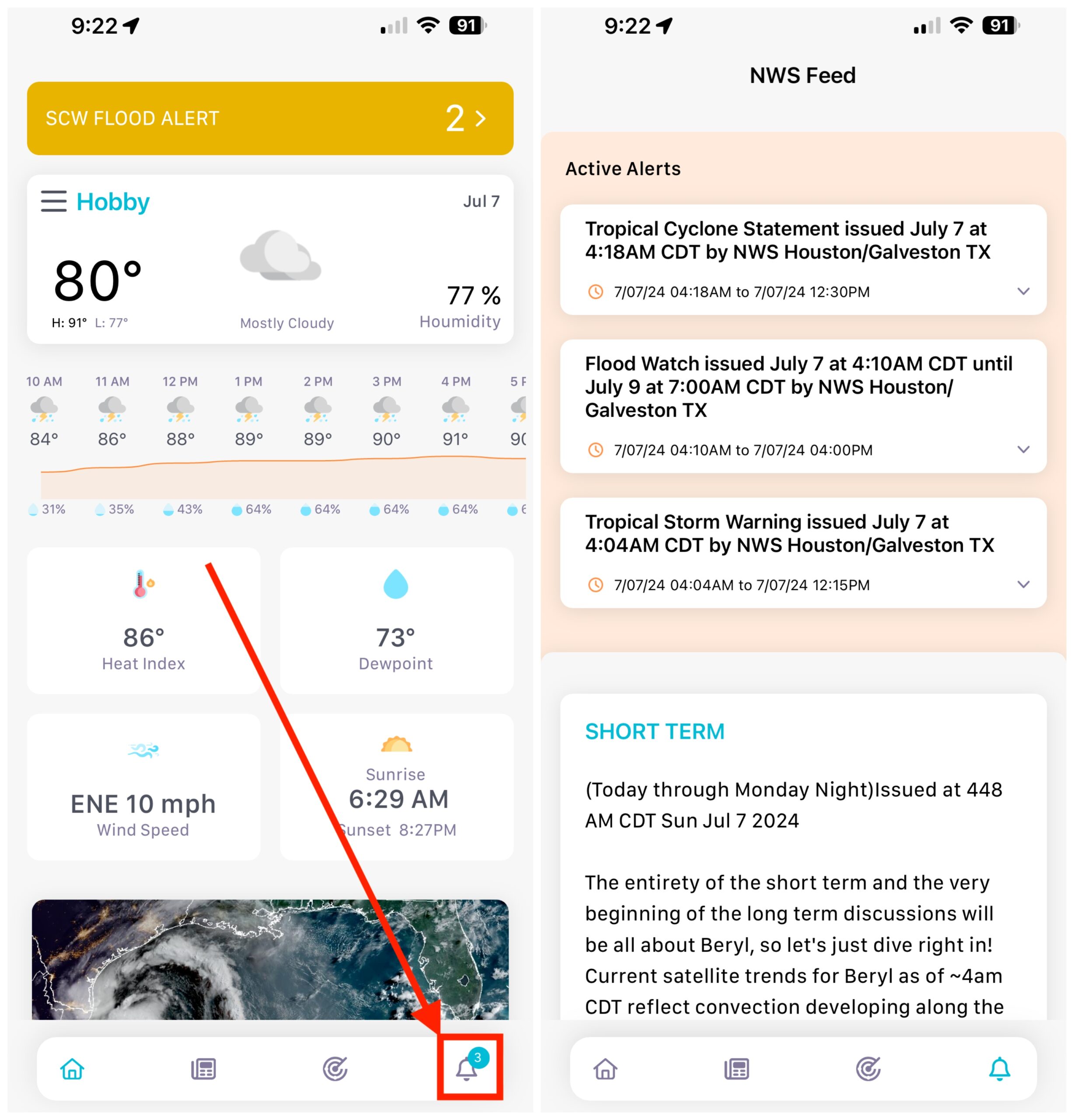In brief: We’re excited to have Dwight Silverman, a veteran Houston tech journalist working with us behind the scenes, write this post about how to find hyperlocal weather forecast information on the powerful computer in your pocket. Dwight explores some of the features and data in your phone’s weather apps that you may not have known existed.
When a storm hits the Houston area, Eric and Matt are inundated with questions about conditions at individual reader locations. They have time to answer a few, but given what needs to be done and the amount of work they have to do, they can’t respond to all of them.
But there’s good news: you’ll often find the answers you’re looking for in the palm of your hand.
Nearly everyone carries a smartphone, and many of the weather apps that come with them can give you much more detail than just the current temperature and the chance of rain. Some let you dig deep into the stats you most want to know about a major storm: wind speed and precipitation. Want to know what the peak wind gusts will be when a storm is forecast closest to you? Or how much rain is expected near you? There’s an app for that. They’re not perfect, and they don’t do a great job of dealing with uncertainty in forecasts, but they do give you a solid idea of what to expect.
This post isn’t meant to be a how-to guide to weather apps, but rather to shed some light on features that you might not realize are there, or that are hidden a few layers deep in an app’s design. There are a lot of third-party weather apps out there, and I’m not going to attempt to cover them all. But I will provide tips for some of the better ones, and those that are included on your phone.
Space City Weather
You may have heard that we have our own free app? We do, and it’s available for both Apple products (iPhones, iPads, Macs) and Android devices. The app is primarily designed to give you quick access to Eric and Matt’s dispatches, current conditions, hourly and daily forecasts for a week, and radar for any of the 12 cities in our region. But one thing you may not realize is that it includes detailed, up-to-date forecasts and advisories from the National Weather Service on storms and dangerous conditions.
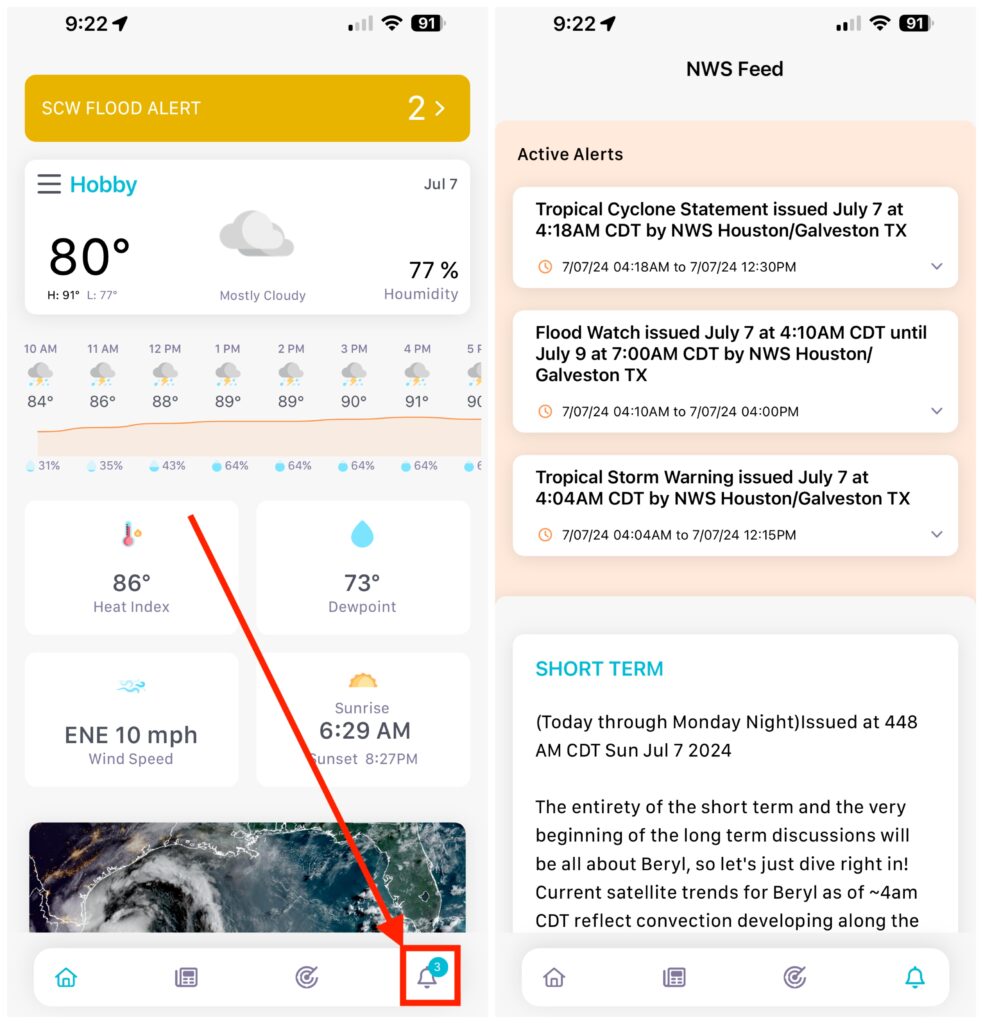
Open the SCW app, tap the bell icon in the lower right corner of the screen to access active warnings and short-term and long-term advisories. There are also discussions about aviation and marine weather as you scroll down. (Please note: the aviation section does NOT tell you if your flight is canceled! Check with your airline and keep an eye on the FAA website for airport status.)
Apple Weather
After Apple acquired the popular Dark Sky app, the app that came with iPhones, iPads and Macs was quickly redesigned to incorporate the former’s hyperlocal forecasting features. It gives you details about conditions – both current and future – at relatively precise locations.
This integration, however, has been, um, not so smooth. Last year, for example, the app failed to load any data, and in other cases it predicted rain when no rain fell. The patient seems to be more stable lately, but it’s a good idea to double-check what you’re seeing in Apple’s Weather app with other sources. (You can find out where Apple gets its weather data here.)
That said, the app makes it easy to see forecasts for specific conditions, particularly wind and precipitation, at your location. On iPhone, iPad, and Mac, it shows your conditions in individual tiles, and tapping on one of them takes you to a screen that lets you jump forward in time to see the forecast for a specific condition.
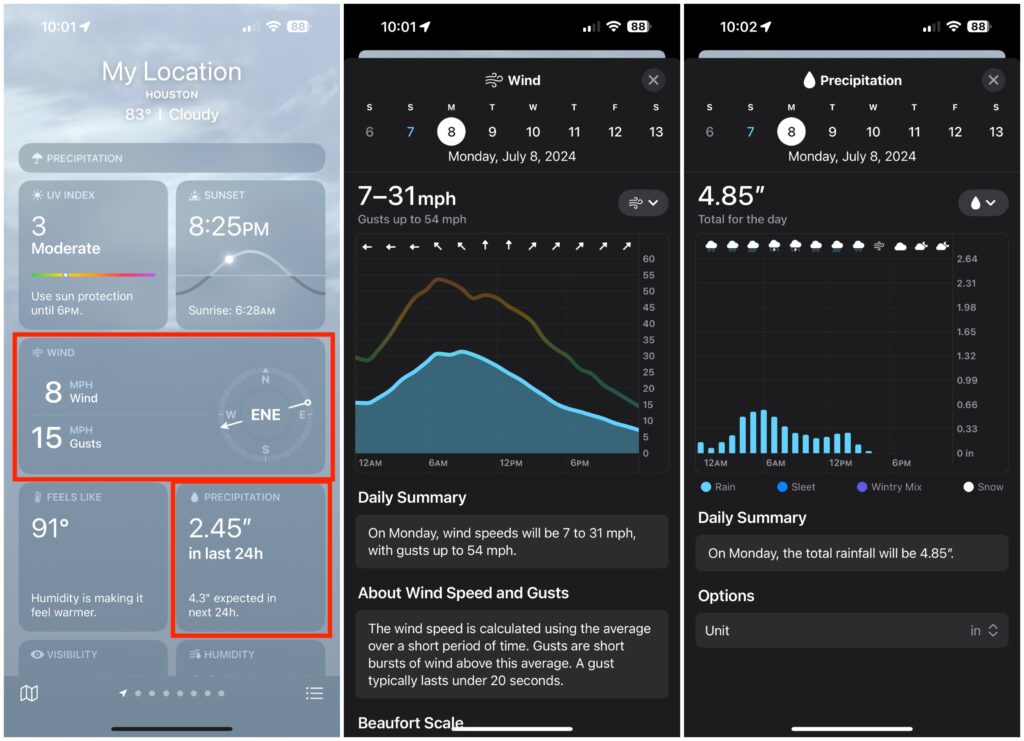
For example, on iPhone, scroll down to the Wind or Precipitation tiles and tap one to get the current conditions for the day in a graph. Scroll left to go to the next day, or tap the calendar date at the top.
Traveling and want to see conditions and forecasts for another location? Enter the postcode in the search field. You can save any location for future use. You will also see forecast alerts, warnings and advisories for those locations.
Android devices
Unlike Apple devices, which all have the same detailed Weather app, Android smartphones and tablets use different apps and services depending on who makes the hardware. For example, Google’s Pixel phones use Google’s own weather service for much of the on-screen information, while Samsung and OnePlus phones direct you to a weather website, usually Weather.com.
But there’s a general strategy you can use: From the list of five- or seven-day forecasts, choose the day you want to explore and tap it. Then look for the metric—wind or precipitation—for the target location.
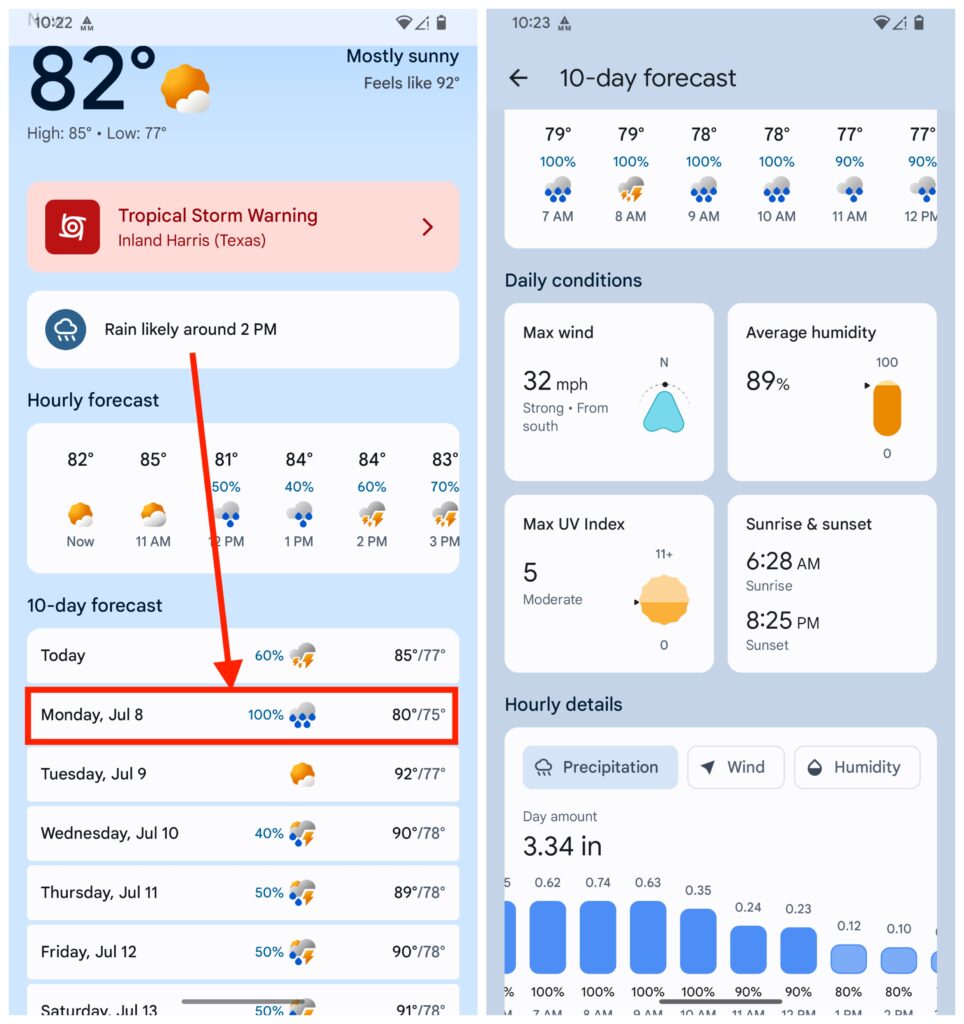
In the image above, tapping the weather widget that appears by default on the home screen of a Pixel phone will take you to a general weather page. From there, tap the day you want details for, then scroll down for wind and precipitation forecasts for that day.
Experiment with the app on your Android phone to find the best route to the information you need.
Now let’s look at some third-party apps that, while not offering all features for free, may still be worth purchasing if you live on the Texas Gulf Coast.
RadarScope
RadarScope is one of the best weather radar apps available. It’s a favorite of Eric, Matt, and mine, and while there is a free tier with limited features, it’s worth the $9.99 annual subscription fee for the Pro 1 tier. (There is a Pro 2 tier, but most people only need Pro 1.) It’s available for Apple devices — and for a one-time fee, you can use it on all Apple products, including the Apple TV 4K streaming box. It’s also available for Android devices and Windows PCs.
This is indeed a professional-grade app, giving you access to a variety of radar technologies and views. Once you unlock one of the Pro levels, you can see the direction storm cells are moving, the location of lightning strikes, and local storm and damage reports from the NWS’s crowdsourced MPing app.

You can select specific radar stations, both in the United States and abroad, including 13 in Texas. It’s easier to use and navigate on a traditional PC, but still extremely useful on your phone. The help files in the desktop version are helpful, and there’s even a Facebook group you can join to learn from other users.
Windy
Windy is available as a website and as an iOS/iPadOS and Android app. As the name suggests, its primary focus is on wind conditions, but it’s actually a full-featured weather app, with one very interesting feature: you can track storms based on computer weather models. Choose the model you want, along with the date and time for a forecast, and it will animate the storm on a beautifully rendered map.
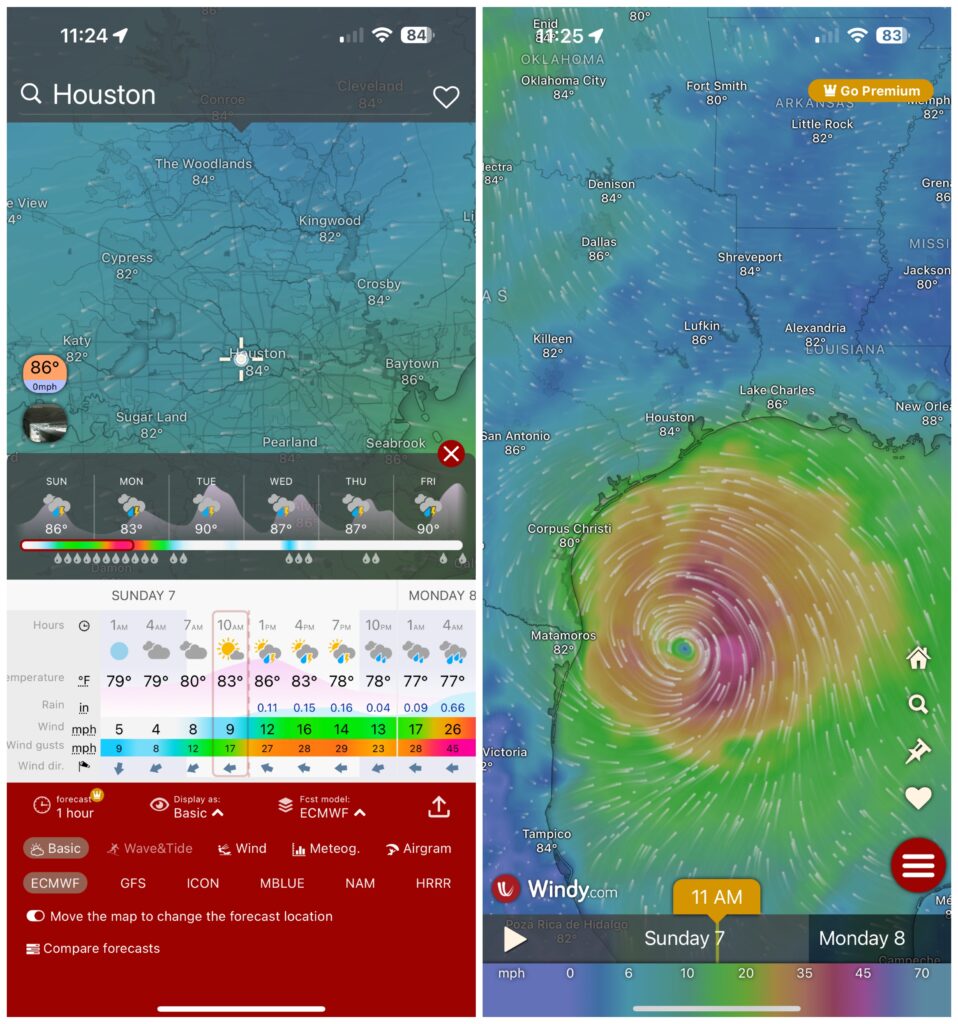
From the home screen, press and hold the Home icon. Tap the Basic label at the bottom to see the different forecast models available. Choose one to see the storm at its current location, then scroll through the timeline to see where the storm is expected to be based on that model’s prediction.
While most of Windy’s features are available for free, some – such as a 15-day forecast – require a subscription, starting at $2.99 per month and going all the way up to $29.99 per year. But most people will be fine with the free version.
There are many, many other weather apps and websites that can help you keep track of storms, and as I said before, this is not meant to be an exhaustive list of resources. (I haven’t even mentioned my favorite, Merry Sky, which is designed for those who miss the look and feel of the old Dark Sky app. Oh, wait, I just did that!) If there’s an app you like, let others know in the comments.

